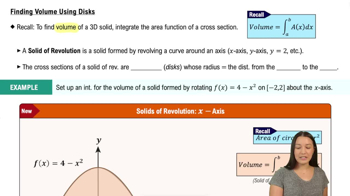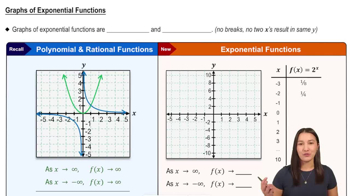Find the volume of the solid whose base is the region bounded by the function and the x-axis with square cross sections perpendicular to the x-axis.
Table of contents
- 0. Functions7h 54m
- Introduction to Functions16m
- Piecewise Functions10m
- Properties of Functions9m
- Common Functions1h 8m
- Transformations5m
- Combining Functions27m
- Exponent rules32m
- Exponential Functions28m
- Logarithmic Functions24m
- Properties of Logarithms36m
- Exponential & Logarithmic Equations35m
- Introduction to Trigonometric Functions38m
- Graphs of Trigonometric Functions44m
- Trigonometric Identities47m
- Inverse Trigonometric Functions48m
- 1. Limits and Continuity2h 2m
- 2. Intro to Derivatives1h 33m
- 3. Techniques of Differentiation3h 18m
- 4. Applications of Derivatives2h 38m
- 5. Graphical Applications of Derivatives6h 2m
- 6. Derivatives of Inverse, Exponential, & Logarithmic Functions2h 37m
- 7. Antiderivatives & Indefinite Integrals1h 26m
- 8. Definite Integrals4h 44m
- 9. Graphical Applications of Integrals2h 27m
- 10. Physics Applications of Integrals 3h 16m
- 11. Integrals of Inverse, Exponential, & Logarithmic Functions2h 34m
- 12. Techniques of Integration7h 41m
- 13. Intro to Differential Equations2h 55m
- 14. Sequences & Series5h 36m
- 15. Power Series2h 19m
- 16. Parametric Equations & Polar Coordinates7h 58m
9. Graphical Applications of Integrals
Introduction to Volume & Disk Method
Problem 8.1.74
Textbook Question
74. Volume of a Solid
Consider the region R bounded by:
The graph of f(x) = 1/(x + 2)
The x-axis on the interval [0,3].
Find the volume of the solid formed when R is revolved about the y-axis.
 Verified step by step guidance
Verified step by step guidance1
Step 1: Recognize that the problem involves finding the volume of a solid of revolution. Since the region R is revolved about the y-axis, we will use the method of cylindrical shells.
Step 2: Recall the formula for the volume of a solid using the method of cylindrical shells: , where x is the radius of the shell, f(x) is the height of the shell, and [a, b] is the interval of integration.
Step 3: Substitute the given function f(x) = 1/(x + 2) and the interval [0, 3] into the formula. The volume becomes: .
Step 4: Simplify the integrand . Perform polynomial long division or rewrite the fraction to make it easier to integrate. This step will involve algebraic manipulation.
Step 5: Integrate the simplified expression with respect to x over the interval [0, 3]. After finding the antiderivative, evaluate it at the bounds 3 and 0, and multiply the result by 2π to find the volume.
 Verified video answer for a similar problem:
Verified video answer for a similar problem:This video solution was recommended by our tutors as helpful for the problem above
Video duration:
4mPlay a video:
Was this helpful?
Key Concepts
Here are the essential concepts you must grasp in order to answer the question correctly.
Volume of Revolution
The volume of revolution refers to the volume of a solid formed by rotating a two-dimensional shape around an axis. In this case, the region R is rotated about the y-axis, which requires the use of integration techniques to calculate the volume. The method of cylindrical shells or the disk/washer method can be applied, depending on the axis of rotation and the function involved.
Recommended video:

Finding Volume Using Disks
Integration
Integration is a fundamental concept in calculus that involves finding the accumulated area under a curve. In the context of finding volumes, integration allows us to sum up infinitesimally small cylindrical slices of the solid formed by the revolution. The definite integral will be evaluated over the specified interval to determine the total volume of the solid.
Recommended video:

Integration by Parts for Definite Integrals
Function Behavior
Understanding the behavior of the function f(x) = 1/(x + 2) is crucial for this problem. This function is continuous and positive over the interval [0, 3], which means the region R is well-defined for the volume calculation. Analyzing the function's properties, such as its limits and shape, helps in visualizing the solid formed and ensures accurate integration.
Recommended video:

Graphs of Exponential Functions

 5:38m
5:38mWatch next
Master Introduction to Cross Sections with a bite sized video explanation from Patrick
Start learningRelated Videos
Related Practice
Multiple Choice
130
views
6
rank
